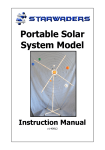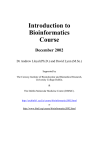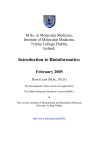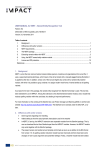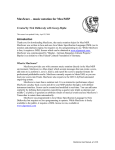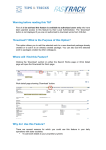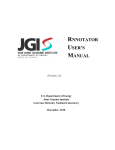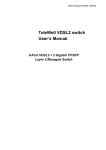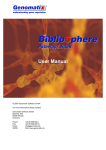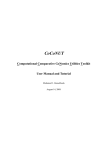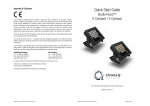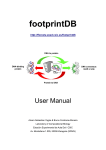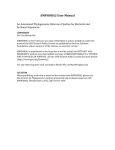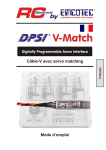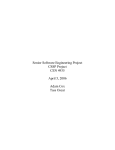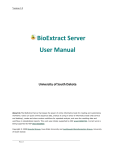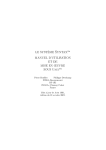Download PoSSuM software distribution User manual
Transcript
PoSSuM software distribution
User manual
Version 2.0
Robert Homann, Michael Beckstette
June 8, 2009
Contents
Contents
Contents
1 Abstract
3
2 Introduction
3
3 File formats
3.1 The PoSSuM -PSSM format
3.1.1 PSSMs . . . . . . . .
3.1.2 PSSM family models
3.2 Frequency file format . . . .
3.3 Custom symbol mappings .
4 PoSSuMsearch
4.1 Description . . . . . . . . .
4.2 Command line options . . .
4.3 Search directions . . . . . .
4.4 Tab delimited output format
4.5 FASTA format . . . . . . .
.
.
.
.
.
.
.
.
.
.
.
.
.
.
.
.
.
.
.
.
.
.
.
.
.
.
.
.
.
.
.
.
.
.
.
.
.
.
.
.
.
.
.
.
.
.
.
.
.
.
.
.
.
.
.
.
.
.
.
.
.
.
.
.
.
.
.
.
.
.
.
.
.
.
.
.
.
.
.
.
.
.
.
.
.
.
.
.
.
.
.
.
.
.
.
.
.
.
.
.
.
.
.
.
.
.
.
.
.
.
.
.
.
.
.
.
.
.
.
.
.
.
.
.
.
.
.
.
.
.
.
.
.
.
.
.
.
.
.
.
.
.
.
.
.
.
.
.
.
.
.
.
.
.
.
.
.
.
.
.
.
.
.
.
.
.
.
.
.
.
.
.
.
.
.
.
.
.
.
.
.
.
.
.
.
.
.
.
.
.
.
.
.
.
.
.
.
.
.
.
.
.
.
.
.
.
.
.
.
.
.
.
.
.
.
.
.
.
.
.
.
.
.
.
.
.
.
.
.
.
.
.
.
.
.
.
.
.
.
.
.
.
.
.
.
4
4
4
6
7
7
.
.
.
.
.
9
9
9
18
19
20
5 PoSSuMdist
21
5.1 Description . . . . . . . . . . . . . . . . . . . . . . . . . . . . . . . . . . 21
5.2 Command line options . . . . . . . . . . . . . . . . . . . . . . . . . . . . 21
5.3 Format of the probability distribution file . . . . . . . . . . . . . . . . . . 23
6 PoSSuMfreqs
23
6.1 Description . . . . . . . . . . . . . . . . . . . . . . . . . . . . . . . . . . 23
6.2 Command line options . . . . . . . . . . . . . . . . . . . . . . . . . . . . 24
7 Using the PoSSuM software distribution
7.1 Examples . . . . . . . . . . . . . . . . . . . . . . . . . .
7.1.1 Basic operation . . . . . . . . . . . . . . . . . . .
7.1.2 Reduced alphabets . . . . . . . . . . . . . . . . .
7.1.3 Computing scores for all substrings . . . . . . . .
7.1.4 Sequence classification with PSSM family models
7.1.5 Speeding up hmmsearch with PSfamSearch . . . .
7.2 Messages and warnings . . . . . . . . . . . . . . . . . . .
7.3 Bugs . . . . . . . . . . . . . . . . . . . . . . . . . . . . .
7.4 Release history . . . . . . . . . . . . . . . . . . . . . . .
2
.
.
.
.
.
.
.
.
.
.
.
.
.
.
.
.
.
.
.
.
.
.
.
.
.
.
.
.
.
.
.
.
.
.
.
.
.
.
.
.
.
.
.
.
.
.
.
.
.
.
.
.
.
.
.
.
.
.
.
.
.
.
.
.
.
.
.
.
.
.
.
.
.
.
.
.
.
.
.
.
.
25
25
25
26
26
27
27
28
30
30
2 INTRODUCTION
1 Abstract
In biological sequence analysis, position specific scoring matrices (PSSMs) are widely
used to represent sequence motifs. In this manual, we describe the PoSSuM software
distribution implementing a new non-heuristic algorithm, called ESAsearch [BHGK06,
BSH+ 04], to efficiently find matches of such matrices in large databases. Our approach
preprocesses the search space, e.g., a complete genome or a set of protein sequences, and
builds an enhanced suffix array which is stored on file. The enhanced suffix array only
requires 9 bytes per input symbol, and allows to search a database with a PSSM in sublinear expected time. We also address the problem of non-comparable PSSM scores by
implementing a method which allows to efficiently compute a matrix similarity threshold
for a PSSM, given an E-value or a p-value. Our method is based on dynamic programming. In contrast to other methods it employs lazy evaluation of the dynamic programming matrix: it only evaluates those matrix entries that are necessary to derive the
sought similarity threshold.
2 Introduction
Position specific scoring matrices (PSSMs) have a long history in sequence analysis
(see [GME87]). A high PSSM score in some region of a sequence often indicates a possible biological relationship of this sequence to the family or motif characterized by the
PSSM. There are several databases incorporating PSSMs, e.g., PROSITE [HSL+ 04],
PRINTS [ABF+ 03], BLOCKS [HGPH00], or TRANSFAC [MFG+ 03]. While these databases are constantly improved, there are only few improvements in the programs searching with PSSMs. E.g., the programs FingerPrintScan [SFA99], BLIMPS [HGPH00],
and MatInspector [QFWW95] still use a simple straightforward O(mn)-time algorithm
to search a PSSM of length m in a sequence of length n. The most advanced program in
this field is EMATRIX [WNB00], which incorporates a technique called lookahead scoring. The lookahead scoring technique is also employed in the suffix tree based method
of [DC00]. This method performs a limited depth first traversal of the suffix tree of the
set of target sequences. This search updates PSSM scores along the edges of the suffix
tree. Lookahead scoring allows to skip subtrees of the suffix tree that do not contain any
matches to the PSSM. Unfortunately, the method of [DC00] has not found its way into
a widely available and robust software system.
In this manual, we describe a new program for searching PSSMs. The overall structure
of the implemented algorithm is similar to the method of [DC00]. However, instead of
suffix trees we use enhanced suffix arrays, a data structure which is as powerful as suffix
trees (cf. [AKO04]). Enhanced suffix arrays provide several advantages over suffix trees,
which make them more suitable for searching PSSMs:
• While suffix trees require about 12n bytes in the best available implementation
(cf. [Kur99]), the enhanced suffix array used for searching with PSSMs only needs
9n bytes of space.
3
3 FILE FORMATS
• While the suffix tree is only computed in main memory, the enhanced suffix array
is computed once and stored on file. Whenever a PSSM is to be searched with, the
enhanced suffix array is mapped into main memory which requires no extra time.
• While the limited depth first traversal of the suffix tree suffers from the poor
locality behavior of the data structure (cf. [GK95]), the enhanced suffix array
provides optimal locality, because it is sequentially scanned from left to right.
One of our algorithmic contributions is a new technique that allows to skip parts of the
enhanced suffix array containing no matches to the PSSM, implemented in PoSSuMsearch. Due to the skipping, we achieve an expected running time that is sublinear in
the size of the search space (i.e., the size of the nucleotide or protein database). As a
consequence, the algorithm scales very well for large data sizes.
When searching with a PSSM it is very important to determine a suitable threshold
for a PSSM match. Usually, the user prefers to specify a significance threshold (i.e., an
E-value or a p-value) which has to be transformed into an absolute score threshold for
the PSSM under consideration. This can be done by computing the score distribution
of the PSSM, using well-known dynamic programming (DP, for short) methods, e.g.,
[Sta89, WNB00, Rah03, RMV03]. The program PoSSuMdist implements such an algorithm. Unfortunately, these methods are not fast enough for large PSSMs. For this
reason, we have developed a new lazy evaluation algorithm that only computes a small
fraction of the complete score distribution, speeding up the computation of the threshold
significantly compared to standard DP methods. This makes our algorithm applicable
for on-the-fly computations of the score thresholds.
In this manual, we first describe the file formats used by the PoSSuM software distribution, followed by descriptions of the programs PoSSuMsearch, PoSSuMdist, and
PoSSuMfreqs. PoSSuMsearch and PoSSuMdist both generate output whose formats are
also described in their respective sections. Finally, a few examples are shown how the
PoSSuM software distribution can be used.
3 File formats
3.1 The PoSSuM-PSSM format
PoSSuMsearch and PoSSuMdist require PSSMs stored in an easy to read ASCII based
file format, combining features supported by other PSSM formats.
3.1.1 PSSMs
In PoSSuM-PSSM format, each line begins with a tag, followed by one white space
character, followed by some data for that tag. All strings are case-sensitive. There must
be no white space before the beginning of any tag. Lines may be empty to separate
4
3 FILE FORMATS
3.1 The PoSSuM-PSSM format
things. Comments are allowed and introduced by a # character at the beginning of a
line, the whole line is considered as a comment then.
These are the general rules. Now, a PSSM is defined in multiple lines, from which the
first one reads
BEGIN type
followed by some other lines making up the PSSM, and the last line
END
indicating the end of a PSSM. The type can be one of INT or FLOAT, depending on the
values used in the scoring matrix. If no floating point values occur in the matrix, then
type should bet set to INT to speed up the search as integers can be processed much
faster on most machines than floats can be.
Valid tags between a PSSM’s BEGIN and END lines are (in any order):
ID The identifier of the PSSM. This tag is required.
AC The accession of the PSSM.
DE A description; any number of DE lines are allowed per PSSM. Multiple description
lines are concatenated in order of occurence and separated by full stops when
displayed by PoSSuMsearch.
AL An alphabet string. Each character in the string stands for one column of the PSSM,
in given order and case-sensitive. The length of the alphabet string determines the
width of the scoring matrix, that is, how many columns are expected to be defined.
AP A name of a predefined alphabet, one of PROTEIN or DNA. Specifying DNA here is
equivalent to specifying an AL line with an alphabet string ACGT; PROTEIN is equivalent to AL ACDEFGHIKLMNPQRSTVWY (note that the exact order of characters is
important, thus the explicit specification of the alphabet strings).
Only one of AL or AP can be used for a PSSM, of course, but one of them is required.
TP A predefined p-value cutoff, called trusted p-value cutoff. This is used when PoSSuMsearch is called with option -trusted.
NP A predefined p-value cutoff, called noise p-value cutoff. This is used when PoSSuMsearch is called with option -noise.
LE The “length” of the PSSM, that is the number of rows. This tag is required.
The values of a scoring matrix are defined using MA tags, one line per matrix row. There
must be as many rows as specified in the LE line, each containing as many values as
there are characters in the alphabet, in the order imposed by the alphabet. All values
are given either as integers or reals as specified by the BEGIN line, separated by white
space. After the first MA line, only MA, empty, or comment lines, or END are permitted.
5
3.1 The PoSSuM-PSSM format
3 FILE FORMATS
The format requires matrices being grouped in so-called PSSM family models for later,
optional chaining; see Section 3.1.2. A group of PSSMs must be surrounded by BEGIN GROUP
and END lines. If your application context does not require grouping, just start the library
file with a BEGIN GROUP line and end it with a final END after the END of the last PSSM.
This declares all PSSMs in the file to belong to the same group.
Internally, each PSSM is identified by a tuple of group identifier and group position. The
group identifier is the position of a group within the profile library file and the group
position is the position of a PSSM within its group. Both quantities are counted up from
0 while the profile library file is read, where the group position counter is reset to 0 for
every new group. Group identifiers and positions can be used for sorting the output (see
description for -sort in Section 4.2) or for PSSM identification when post-processing the
output by external programs.
A valid, artificial example for a PSSM library file is
BEGIN GROUP
BEGIN INT
ID Some matrix identifier
AC Some accession
DE A description describing the PSSM
DE Multiple description lines are possible
AP DNA
LE 3
#
A C G T was specified by "AP DNA"
MA 5 -1 -6 2
MA -4 4 -1 -5
MA 0 -3 3 -4
END
BEGIN FLOAT
ID Some other matrix identifier
DE Another description
AL AUCG
LE 2
#
A
U
C
G
MA 0.0 -3.5 3.2 -4.8
MA -4.2 -1.0 4.0 -5.8
END
END
3.1.2 PSSM family models
A PSSM family model is defined by the set of PSSMs in between BEGIN GROUP and
END GROUP lines.
Valid tags between the PSSMs are (in any order):
TL This value gives the minimum length of a valid matching chain when using trusted
p-value cutoffs (see PoSSuMsearch option -trusted and PSSM tag TP).
6
3 FILE FORMATS
3.2 Frequency file format
NL This value gives the minimum length of a valid matching chain when using noise
p-value cutoffs (see PoSSuMsearch option -noise and PSSM tag NP).
The tags can be given before the first PSSM inside a group, after the last one, or
anywhere in-between, but not inside a PSSM definition.
3.2 Frequency file format
A frequency file consists of simple character/value pairs, one pair per line. It serves for
proper probability distribution calculation for E- and p-values for the PSSMs based on
a specific input sequence, so its content should not just be a wild guess.
A line starts with a single character, followed by white space, followed by the relative
frequency of that character in the input sequence. The relative frequency is a real number
in the interval [0, 1], the sum of all frequencies specified in one file should be 1.0, such
that they constitute a sequence dependent character distribution.
Comments are allowed and introduced by a # character at the beginning of a line, the
whole line is considered as a comment then. Empty lines are permitted.
A valid example for a uniform distribution on DNA data is
#
A
C
G
T
This is a uniform distribution which is usually the wrong choice for real data.
0.25
0.25
0.25
0.25
Note that instead of “T 0.25” it would be equivalent to specify “U 0.25” or two separate
lines reading
T 0.15
U 0.1
if the input sequence alphabet were to define “T” and “U” being the same. Frequencies
of equivalent characters are summed up. See below for more information about symbol
mappings.
See Section 6 on page 23 for the description of a tool for determining relative frequencies
of characters from an input sequence.
3.3 Custom symbol mappings
To work on some sequence, PoSSuMsearch, PoSSuMdist, and PoSSuMfreqs all need to
know the sequence’s underlying alphabet. If the input sequence is an enhanced suffix
array built by mkESA1 or mkvtree2 , then this information is stored in the suffix array
1
2
http://bibiserv.techfak.uni-bielefeld.de/mkesa/
from the Vmatch package, see http://www.vmatch.de/
7
3.3 Custom symbol mappings
3 FILE FORMATS
project. If the input sequence is a plain text format like Fasta, though, the user must
either provide a symbol mapping file, or use the command line options -dna or -protein
to specify a predefined (built-in) alphabet.
The format of symbol mapping files is the same as the format used in Vmatch, which
is because the PoSSuM software distribution is based on the same libraries as Vmatch.
Each line consists of a string of characters that should be regarded as equal. E.g., the
file
aA
cC
gG
tT
*
defines a case-insensitive DNA alphabet. The last line specifies a group of special wildcard characters (only “*” in the example). Actually the wildcard is just an ordinary
character treated in a special way internally. Note that the symbol mapping parser is
quite picky and requires the last line to be terminated by a newline character.
Internally, all characters read from the input sequence are mapped to integers, and all
characters that appear on the same line of the symbol mapping file are mapped to the
same integer such that there is really no difference between them internally.
Use of symbol mappings is important for several reasons:
• Validation of the input sequence (invalid characters can be detected and therefore
never occur during searching or in the output).
• Special treatment for case-(in)sensitivity, or more generally, character classes (like
“t”=“T”=“u”=“U”), is unnecessary because these cases are handled at the alphabet transformation level.
• The alphabet imposes an order on its characters by mapping them to integers (e.g.,
“a” and “A” may be mapped to 0, “c” and “C” to 1, etc.). Columns of PSSMs are
ordered according to some alphabet, too (first column may stand for “A”, second
for “C”, etc.). If the order of the input sequence alphabet is different from the
PSSM’s alphabet, then the columns of the PSSM can be reordered according to
the order of the input sequence alphabet (otherwise, the user would be urged to
provide his PSSMs with their columns in input sequence alphabet order), and this
can be done with character classes being handled correctly (if the input sequence
is encoded using the alphabet from the example above and the PSSM has some
column for “U”, then this column is read whenever a “t”, “T”, “u”, or “U” appears
in the input, additional columns for any of “t”, “T”, or “u” will be flagged as an
error because of ambiguities).
8
4 POSSUMSEARCH
4 PoSSuMsearch
4.1 Description
This is the main searching program. It implements ESAsearch for searching PSSMs
in an enhanced suffix array, and the lazy dynamic programming evaluation algorithm
for threshold derivation from E- and p-values. Additionally, other search algorithms
LAsearch and simple search for plain text formats such like Fasta are implemented. As
an alternative to the lazy dynamic programming evaluation algorithm, a precalculated
probability distribution generated by PoSSuMdist (see Section 5 on page 21) can be
used to derive PSSM thresholds.
4.2 Command line options
The searching program PoSSuMsearch is called as follows:
possumsearch [options]
Valid choices for options are
-help
Show options and terminate with error code 0.
-db dbfile
Name of a database to search in, which can be either an enhanced suffix array, or
a Fasta, Genbank, or Embl file. The sequence must consist of characters over
the alphabet as specified by the options -dna, -protein, or -smap, see below. This
option is mandatory.
-pr matrixfile
Name of a profile library file. A “library” here is a collection of one or more PSSMs
stored in the format as described in Section 3.1 on page 4. This option is mandatory.
-protein
This option is equivalent to the option -smap mapfile where mapfile stores exactly
the following 21 lines:
L
V
I
F
K
R
E
D
A
G
9
4.2 Command line options
4 POSSUMSEARCH
S
T
N
Q
Y
W
P
H
M
C
XBZ*
This specifies an alphabet of size 20 with additional wildcard symbols on the
last line. See Section 3.3 on page 7 or the Vmatch manual for a more detailed
explanation of the format of symbol mapping files.
-dna
This option is equivalent to the option -smap mapfile where mapfile stores exactly
the following 5 lines:
aA
cC
gG
tTuU
nsywrkvbdhmNSYWRKVBDHM
This specifies an alphabet of size 4 with additional wildcard symbols appearing in
the fifth line. See Section 3.3 on page 7 or the Vmatch manual for a more detailed
explanation of the format of symbol mapping files.
-smap mapfile
Specify the file storing the symbol mapping. If the given mapfile cannot be found in
the directory where PoSSuMsearch is run, then all directories specified by the environment variable MKVTREESMAPDIR are searched. If defined correctly, this contains
a list of directory paths separated by colons (“:”).
If the file can’t be found, an error message is reported and the program exits with
error code 1. See Section 3.3 on page 7 or the Vmatch manual for a more detailed
explanation of the format of symbol mapping files.
-freq freqfile
Specify the file storing the relative frequencies of characters in the input sequence.
See Section 3.2 on page 7 for file format reference and Section 6 on page 23 for a
description of PoSSuMfreqs, a simple program for generating frequency files from
a database.
-uniform
If no frequency file is available, this option can be specified to assume characters
being distributed uniformly. Note that this option is not meant for regular use—for
10
4 POSSUMSEARCH
4.2 Command line options
accurate results, determining the real character distribution and specifying it via
-freq is mandatory.
-pdis distfile
Specify the file storing a precalculated probability distribution as generated by
PoSSuMdist for fast computation of E- and p-values for the PSSMs. The file must
match the profile library specified by -pr and the alphabet of the input sequence.
Because frequency information was already used when the distribution was precalculated by PoSSuMdist, options -freq and -uniform are prohibited when using
this option. See Section 5.3 on page 23 and PoSSuMdist description for further
information. Alternatively, -lazy can be used.
-lazy
Use lazy dynamic programming for fast computation of E- and p-values for the
PSSMs as described in [BHGK06].
-esa
Search the PSSMs via ESAsearch as described in [BHGK06]. This option is only
valid if the dbfile given to -db is an enhanced suffix array which must have been
built by mkESA or mkvtree beforehand.
-lahead
Search the PSSMs via LAsearch as described in [WNB00, BHGK06]. This option
can be used with all kinds of input sequences.
-simple
Search the PSSMs via the simple search algorithm as implemented in FingerPrintScan, Blocksearch [HH91], BLIMPS , MatInspector , and probably others. This
option can be used with all kinds of input sequences, but should be used for debugging and benchmarking only due to its inferior efficiency.
-eval E-value
Specify E-value cutoff. This option must be combined with either -lazy or -pdis.
E-value calculation is based on p-values, it is simply the p-value times database
size. If combined with -seqrange, the database size is still assumed to be the size
of the whole input sequence, not just the range’s size. Use -dbsize to modify the
database size for E-value calculation.
-pval p-value
Specify p-value cutoff. This option must be combined with either -lazy or -pdis.
-trusted
Use the trusted p-value cutoffs as specified in the PSSM library file. If this option
is given, then a trusted p-value cutoff must be defined for each PSSM in the library
file. This option must be combined with either -lazy or -pdis.
11
4.2 Command line options
4 POSSUMSEARCH
-noise
Use the noise p-value cutoffs as specified in the PSSM library file, otherwise the
same as -trusted.
-mssth similarity
Specify a matrix similarity score (MSS) cutoff. MS-scores are PSSM scores rescaled
to the interval [0, 1] with the minimum reachable PSSM score corresponding to 0
and the maximum reachable PSSM score corresponding to 1. This scoring scheme is
used in MatInspector and Match [KGR+ 03]. Note that because PSSM thresholds
can be derived from similarity without use of probability distributions, they will
not be calculated by default and E- and p-values will not be available in the
results. If this information is required, also specify -freq, -uniform, or -pdis to tell
PoSSuMsearch how the probability distributions for displaying E- and p-values
should be obtained. If -freq or -uniform is used, a full probability distribution
must be calculated for each matching PSSM which can be slow, using -pdis is the
better choice then.
-rawth threshold
Specify a raw, global threshold for all PSSMs. As PSSM thresholds are set directly
and hence no probability distributions are required to do so, the same discussion
about E- and p-values as for -mssth applies.
-best k
Find the k > 0 best (meaning highest scoring) matches per PSSM. If there are less
then k matches, only those are printed. This option can only be used in conjunction
with -esa and -lahead. Searching with reduced alphabets on enhanced suffix arrays
(options -realpha and -esa), however, does not work together with this option.
Note that since in general matches are found in different order for -esa and -lahead,
their results may also slightly differ (e.g., this is the case when asking for, say, the
best three matches, but there are actually a total of five best equally scoring
matches in the database, then two of them never get reported—this is not a bug).
Also note that the threshold used for searching reported for each match (the value
printed after “threshold” in human readable output, field 9 in tab delimited output,
see Section 4.4 on page 19) is quite useless if -best is specified.
-all
If a PSSM fails to code for the specified cutoff, e.g., if a p-value of 10−30 was
specified, but the PSSM is only capable to code for a p-value of 10−20 , then that
PSSM is not searched for by default and a warning is issued instead. If this option
is specified, then in these cases the threshold is set to the maximum possible score
the PSSM can yield, so it could match nonetheless (with a p-value higher than
requested, though).
-dbsize size
Assume the database size is size as basis for E-value calculation. This option af-
12
4 POSSUMSEARCH
4.2 Command line options
fects E-value calculation exclusively. By default, the original database size is used.
Option -seqrange does not affect the default value.
-realpha
This option is specific to protein data/PSSMs. A problem with protein data is the
large alphabet (when compared to DNA) involved which slows down the ESAsearch
algorithm. A solution is to build an enhanced suffix array using a smaller custom
alphabet which defines groups of amino acids as single representative characters,
and to search the PSSMs on that reduced alphabet size index.
Usually PSSMs are converted to match the input sequence alphabet, such that an
error would be issued when a protein PSSM was searched in an enhanced suffix array built with such a reduced alphabet. The problem then is that groups of distinct
profile columns are mapped to the same sequence character representing a group,
and when scoring that character there is no way to decide which of the PSSMs’
columns should be used for scoring. So to handle this application case properly, the
-realpha option must be specified. PSSMs are then read as if the input sequence
was encoded by the standard protein alphabet, i.e., for enhanced suffix arrays as
if they had been built using the -protein option, and for flat files (like Fasta) as
if -protein had been passed to PoSSuMsearch (see description for -protein above).
PSSMs are converted internally according to the reduced sequence alphabet and
searched in the reduced sequence, the intermediate matches found are applied to
the original PSSMs and original input sequence to calculate the correct match
scores. Since reduced alphabets are specific to protein data, options -rc and -fc
cannot be used together with -realpha, of course.
Note that for applying this option to an enhanced suffix array, it must have been
built so to include the original input sequence (option -g ois for mkesa, option -ois
for mkvtree). To specify a reduced alphabet, write a symbol map file as described
in Section 3.3 on page 7 or in the Vmatch manual and pass that symbol map to
the enhanced suffix array construction program (option -a for mkesa, option -smap
for mkvtree). Using this option for flat files doesn’t make much sense but is still
supported, use PoSSuMsearch’s -smap option then. Also don’t expect any speed-up
when using reduced alphabets with the LAsearch algorithm.
All PoSSuMsearch options retain their original semantics even if -realpha is specified, e.g., -pval specifies a p-value cutoff for the PSSMs as if they were searched
directly in the protein data, hence optionally passed frequencies or precalculated
distributions must refer to the standard protein alphabet. See Section 7.1 for a
complete example on how to use this option.
There is one drawback, though: if both -esa and -best are specified, then this option
cannot be used. If -best is needed, use -lahead or a full alphabet size version of the
index (i.e., no -realpha) instead.
-sort keys
Specify order in which matches should be reported. If this option is omitted, the
13
4.2 Command line options
4 POSSUMSEARCH
output is not sorted in any special way. The keys argument is a string of keys the
output is to be sorted by, priority in order of keys. Valid keys are
i PSSM identifier, sorted in lexical order. This is the string that is specified in the
ID tag.
a PSSM accession, sorted in lexical order. This is the string that is specified in
the AC tag.
p p-value of match, smallest first.
e E-value of match, smallest first.
m MSS of match, largest first.
s Score of match, largest first.
n Sequence number, smallest first.
o Position of match in sequence, smallest first.
r Group identifier.
t Group position.
g Group identifier and position, short for “rt”.
E.g., to get results sorted by E-value in first place and sequence number in second
place, specify “-sort en”. Matches with both the same E-values and sequence
numbers again are not sorted in any special way.
Note that a pair of group identifier and group position (sort key “g”) always
identifies exactly one PSSM, but a PSSM identifier together with its accession
(sort keys “ia” or “ai”) may not because multiple PSSMs with equal identifiers
and accessions can be specified. If unsure, use “iag” instead of “ia” or “aig”
instead of “ai” to make sure to have PSSMs with both the same identifier and
accession separated in the output. Also note that specification of “gia” or “gai”
is equivalent to only specifying “g” because if PSSMs are already sorted by group
identifier and position in first place, then further sorting by PSSM identifier or
accession is not possible (read: unnecessary). In other words, specification of “g”
just separates matches by PSSM in order of occurence in the profile library, “iag”
or “aig” arrange them in alphabetical order and then make sure to have distinct
PSSMs with equal identifier and accession strings being separated.
-modsearch count
Search with PSSM family models, and report matching chains for up to count
different models per sequence. The count best matching chains in a sequence are
shown; if multiple chains are found for some model in the same sequence, then
only the highest-ranking chain might be shown for that particular combination of
model and sequence. That is, up to count chains are shown per sequence, and each
chain belongs to a different model.
Typically, this option is combined with one of -trusted or -noise, and possibly also
with -mclen or -mrclen. See also Sections 7.1.4 and 7.1.5.
14
4 POSSUMSEARCH
4.2 Command line options
-seqclass count
Search with PSSM family models, and for each model, report the best matching
chains in up to count different sequences. The count best matching chains for a model
are shown; if multiple chains are found for some model in the same sequence, then
only the highest-ranking chain might be shown for that particular combination of
model and sequence. That is, up to count chains are shown per model, and each
chain belongs to a different sequence.
Typically, this option is combined with one of -trusted or -noise, and possibly also
with -mclen or -mrclen. See also Sections 7.1.4 and 7.1.5.
-mclen len
Do not report chains shorter than len , i.e., make sure that a match to a PSSM
family model consists of at least len different single PSSM matches defined in that
model. By default, len is set to 1 so that there is no restriction on the minimum
length. Note that this parameter can be defined for each individual PSSM family
model by inserting TL and/or NL lines into the model definition. When given, this
option overrides the value specified on TL and NL lines.
-mrclen ratio
Like -mclen, this option restricts the minimum chain length, but the restriction
depends on the size of the PSSM family models; chains of length l found for a
PSSM family model consisting of k PSSMs are accepted only if kl ≥ ratio holds.
-format fmt
Specify output format, where fmt is one of
human
cisml
tabs
fasta
null
a human readable multiline format;
CisML [HW04], an XML-based format;
tab delimited output (see Section 4.4 on page 19);
FASTA format (see Section 4.5 on page 20); or
no output.
-fn
Search on forward strand (default). This option works with any alphabet and
replaces the -fwd option of previous versions of PoSSuMsearch. See also -rc, -rn,
and -fc. See Section 4.3 on page 18 and Figure 1 for a more detailed explanation
on the options concerning search directions.
-rc
Search for reverse complementary matches. This option disables the default of
searching on the forward strand—specify an extra -fn to search on both strands,
or use option -2 or even -4. This is a DNA specific option, i.e., the input alphabet
must be a DNA alphabet (or in better words, a DNA compatible alphabet, not
necessarily generated via the -dna option of PoSSuMsearch or mkvtree), and, of
course, the PSSMs should encode DNA motifs.
15
4.2 Command line options
4 POSSUMSEARCH
The reason for the DNA specificity is that internally the PSSMs’ columns are
exchanged (“A”-column with “T”- or “U”-column and “C”-column with “G”column), their rows are reversed in order, and then a usual search in forward
direction is done. Because PoSSuMsearch supports arbitrary alphabets to be used
for both, input sequences and PSSMs, the column exchange must be done carefully,
the compatibility of both alphabets must be checked, and character classes must
be recognized (“T” and “U” could be distinct characters in the input sequence).
Note that PoSSuMsearch does not attempt to recognize whether the alphabets are
strictly DNA or not, it just tries to find those columns unambiguously labelled
with characters from the DNA alphabet and exchanges them. If columns cannot
be exchanged for some reason, the program will tell so and exit with error code 1.
See Section 4.3 on page 18 and Figure 1 for a more detailed explanation on the
options concerning search directions. See also option -ncompl.
A more general, non-DNA specific approach could be implemented by requiring
the user to explicitly specify the columns to be exchanged instead of autodetecting
them, but it would be harder to use without any gain in practical use. Expect no
problems when using option -dna throughout.
-rn
Search for reverse matches. The PSSMs’ rows are reversed in order and a usual
search in forward direction is done. This option works with any alphabet. See
Section 4.3 on page 18 and Figure 1 for a more detailed explanation on the options
concerning search directions.
-fc
Search for complementary matches. Alike -rc, this is a DNA specific option, i.e.,
the input alphabet must be a DNA alphabet and the PSSMs should encode DNA
motifs. Internally, the PSSMs’ columns are exchanged as with -rc and a usual
search in forward direction is done, but the PSSMs’ rows are not reversed in order.
This option replaces the (misnamed) option -rev of previous versions of PoSSuMsearch. See Section 4.3 on page 18 and Figure 1 for a more detailed explanation
on the options concerning search directions. See also option -ncompl.
-2
Short for -fn and -rc. If searching for forward and reverse complementary matches,
this option is usually what you want. See Section 4.3 on page 18 and Figure 1 for
a more detailed explanation on the options concerning search directions.
-4
Short for all of -fn, -rc, -rn, and -fc. See Section 4.3 on page 18 and Figure 1 for
a more detailed explanation on the options concerning search directions.
-ncompl
By default, the matching sequences for matches on the complementary strand
(options -rc and -fc) are printed out complemented, i.e. not as they appear in
16
4 POSSUMSEARCH
4.2 Command line options
the input sequence. E.g., ACG is a matching sequence to the first PSSM in Section 3.1.1 on page 6 with a threshold of 12 on the forward strand. A reverse
complementary matching sequence to the same PSSM with threshold 12 is CGT,
possibly occuring somewhere else on the reverse complementary strand. In this
case, the string that really occurs in the input sequence is GCA since the input
sequence is always considered to be the forward strand. Without this option, the
matching sequence will be printed as CGT, and as GCA otherwise. See Section 4.3 on
the next page and Figure 1 for a more detailed explanation on the options concerning search directions.
-seqrange range
When using -lahead or -simple, search only in a range of sequences, not all. The
range is specified as min:max pair, including the borders. A range of 30:39 will
search only in sequences 30 to 39, including sequence 30 and 39. Sequence numbers
always start at 0.
-mult factor
For probability distribution calculation, the values of the scoring matrices are
scaled by the value of factor . The default value of factor is 1.0. To speed up calculation of E- and p-values at the price of loss of precision and to reduce disk
space when writing the distribution to file using PoSSuMdist, choose a value from
interval (0, 1). This effects in a compression of PSSM score ranges and thereby a
reduction of computation time for the probability distribution calculation. E.g.,
a value of 0.1 speeds up the probability distribution calculation for a PSSM by
approximately a factor of 10 (because the PSSM’s score range is only a tenth of
the original range then), but this also means that every 10 consecutive score values
achievable by a PSSM are condensensed into one single p-value, which is likely to
produce false positives and false negatives.
To enhance precision in some cases, choose a value greater than 1, resulting into an
expansion of score ranges. Since floating point PSSMs must be rounded to integers
for our dynamic programming method, a value greater than 1 can help getting
better E- and p-values for PSSMs containing very small values.
This option should be used with great care. PSSMs with smaller score ranges are
more prone to rounding errors than those with larger ranges. Larger score ranges
result into considerably more space consumption by the probability distribution
calculation.
-qm
Do not print status messages to stderr.
-qw
Do not print warnings to stderr.
-q
Quiet, do not print anything to stderr. This is equivalent to specifying both -qm
17
4.3 Search directions
4 POSSUMSEARCH
1
3
5′
3′
forward
...
reverse complementary
3′
5′
4
2
Figure 1: The search directions supported by PoSSuMsearch. If the data is DNA, then
there are four cases to consider, namely searching with a PSSM (1) in forward
direction on forward strand (option -fn, default), (2) in reverse direction on
reverse complementary strand (option -rc), (3) in reverse direction on forward
strand (option -rn), and (4) in forward direction on reverse complementary
strand (option -fc). Note that the arrows denote directions in a biologically
correct sense since DNA is commonly read from 50 - to 30 -end. The lower strand
in the figure is the complement to the upper strand, not the reverse. In case of
non-DNA data, the lower strand does not exist, and so then do cases (2) and
(4) not.
and -qw. Matches are still written to stdout.
-version
Show program version. Option –version is a synonym for this option.
The program will terminate silently with error code 0 if no error occured. On error, it
will terminate with error code 1 and print the error to stderr.
4.3 Search directions
On any data, PoSSuMsearch supports searching with PSSMs in forward and reverse
directions in order to find matches to the provided PSSMs and their reverse. Additionally,
on DNA data, searching on the complementary strand is possible. This sums up to a total
of four cases, see Figure 1 for reference. PoSSuMsearch offers command line switches to
choose any combination of these, the default is -fn (search for matches on the forward,
non-complementary strand). Specifying one of the other options disables -fn, so -fn must
be specified explicitly if this is also required. Cases (1) and (3) can be used independently
of the alphabet, cases (1) and (2) are most commonly used on DNA data. Whether or
not cases (3) and (4) are especially useful in practice is arguable, though, still we provide
options for these since the user usually knows better what he wants than we do. For
convenience, option -2 can be used to search for matches falling into the categories of
cases (1) and (2). Use option -4 to search for matches in all four possible ways.
18
4 POSSUMSEARCH
4.4 Tab delimited output format
Within PoSSuMsearch, only the forward, non-complementary strand is known, as provided by the user, represented by the upper strand in Figure 1. Searching in reverse
direction is implemented by reversing the PSSM’s row order, covering cases (2) and (3).
Searching on the complementary strand is accomplished by alphabet transformation,
i.e., by permuting the PSSM’s columns according to Watson-Crick base pairing, covering cases (2) and (4). The sequence itself remains unchanged. Since a match does not
imply the existence of corresponding matches on the complementary strand nor does it
imply the existence of reverse matches, PoSSuMsearch must search explicitly for every
possible case, hence passing option -4 results in roughly a 4-fold time consumption for
the search phase compared to when searching for a single case.
There are various possible ways one could think of to report reverse and/or complementary matches. In PoSSuMsearch, matches are always reported with respect to the forward
strand since this is the only sequence that is explicitly represented in the computer and
stored in the database. The left-most position of a match relative to the beginning of
the sequence the match occurs in is shown as the start position, starting with position 0,
regardless of search direction. E.g., the matching positions for the instances of cases (1)
to (4) in Figure 1 would be reported as marked as 2, n − 10, n − 5, and 4, respectively,
where n is the number of characters in the sequence. The matching sequence is printed
in forward direction as occuring in the database, so in particular, not in reverse even if
the match was found on a reverse strand. For matches on the complementary strand, the
complementary sequence is printed as matching sequence. To get the matching sequences
as they occure in the database (i.e., on the non-complementary forward strand), specify
option -ncompl.
4.4 Tab delimited output format
For each match a single line containing 18 entities is output. They are, separated by
tabulators
1. matched PSSM’s identifier (ID),
2. matched PSSM’s accession (AC),
3. matched PSSM’s description (DE, multiple lines separated by “. ”),
4. group identifier, which is the position of the group in the profile library file that
the PSSM belongs to, starting at 0,
5. position of PSSM within its group, starting at 0,
6. start position of the match with respect to the beginning sequence the match
occurs in, starting at 0 (see Section 4.3 for more details on this),
7. length of the match,
19
4.5 FASTA format
4 POSSUMSEARCH
8. search direction (“fn” for forward non-complementary, “rc” for reverse complementary, “rn” for reverse non-complementary, “fc” for forward complementary,
see Section 4.3),
9. threshold used for searching (value is useless if -best was specified since there is
no specific predefined threshold in that case),
10. match score,
11. minimum score the PSSM can achieve,
12. maximum score the PSSM can achieve,
13. p-value,
14. E-value,
15. MSS,
16. matching sequence number, starting at 0,
17. matching sequence description (multiple lines separated by “. ”), and
18. matching substring (see also Section 4.3 and PoSSuMsearch option -ncompl).
Note that tabulators in string entities (descriptions, identifier, etc.) are not filtered and
may therefore cause problems when parsing an output containing such a string.
If the probability distribution is not available during match evaluation (maybe because
-mssth or -rawth was specified but neither -pdis nor -freq), the fields for E- and p-value
will still be there, but left empty. The same is true for missing information due to lack
of AC or DE tags in the PSSM specification or missing sequence description. A parser
reading tab delimited PoSSuMsearch output should take this into account.
4.5 FASTA format
The FASTA format is very simple; it contains lines starting with a “>” character immediately followed by a sequence description, and lines containing sequence data attibuted
to the nearest description line preceeding the sequence.
When selecting FASTA as output format for PoSSuMsearch, please beware of the fact
that FASTA contains sequences only, and that whole sequences are reported as matches
as they are stored in the sequence database. In particular, there will be no information
about the nature of the matches found, their positions, their scores, etc., and a sequence
will be reported multiple times when multiple matches are found in that sequence.
20
5 POSSUMDIST
5 PoSSuMdist
5.1 Description
This is a supplementary program for PoSSuMsearch. It is used to precalculate the complete probability distribution which is used to derive PSSM thresholds from E- and
p-values. This can be useful if the same PSSM library is searched multiple times and
lazy evaluation within PoSSuMsearch should be circumvented. Note that a complete
probability distribution may require a significant amount of space on file and can take
a long time to calculate.
In PoSSuMsearch, it is not possible to use a generated probability distribution file with
PSSM libraries different from that given to PoSSuMdist to generate the distribution. It
is not even possible if PSSMs are only rearranged within, deleted from or inserted into
that PSSM library. Hence the use of precalculated probability distributions decreases
the grade of flexibility in favor of speed.
5.2 Command line options
The program for probability distribution calculation PoSSuMdist is called as follows:
possumdist [options]
Valid choices for options are
-help
Show options and terminate with error code 0.
-pr matrixfile
Name of a profile library file. A “library” here is a collection of one or more PSSMs
stored in the format as described in Section 3.1 on page 4. This option is mandatory.
-protein
Generate a probability distribution file for an input sequence encoded by the standard protein alphabet as described in the description of PoSSuMsearch option
-protein.
-dna
Generate a probability distribution file for an input sequence encoded by the standard DNA alphabet as described in the description of PoSSuMsearch option -dna.
-smap mapfile
Generate a probability distribution file for an input sequence encoded by the symbol mapping defined in mapfile . See the description of PoSSuMsearch option -smap
for more details.
21
5.2 Command line options
5 POSSUMDIST
-db dbfile
Generate a probability distribution file for the enhanced suffix array dbfile . This
option is used for convenience to just read the symbol mapping from an enhanced
suffix array. The enhanced suffix array itself is not read.
-freq freqfile
Specify the file storing the relative frequencies of characters in the input sequence.
See Section 3.2 on page 7 for file format reference and Section 6 on the facing page
for a description of PoSSuMfreqs, a simple program for generating frequency files
from a database.
-uniform
If no frequency file is available, this option can be specified to assume characters
being distributed uniformly. Note that this option is not meant for regular use—for
accurate results, determining the real character distribution and specifying it via
-freq is mandatory.
-pdis distfile
Specify the name of the output file storing the precalculated probability distribution. This file can be used later by PoSSuMsearch only in conjunction with the
profile library specified by -pr and input sequences encoded by the specified alphabet. Note that the factor of -mult given to PoSSuMdist will be encoded into
distfile , hence it can’t be changed by a later invokation of PoSSuMsearch. See Section 5.3 on the next page for format description and more information.
-mult factor
The values of the scoring matrices are always scaled by the value of factor , which
defaults to 1.0. See the description of the PoSSuMsearch option -mult on page 17
for more details.
-qm
Do not print status messages to stderr.
-qw
Do not print warnings to stderr.
-q
Quiet, do not print anything to stderr. This is equivalent to specifying both -qm
and -qw.
-version
Show program version. Option –version is a synonym for this option.
The program will terminate silently with error code 0 if no error occured. On error, it
will terminate with error code 1 and print the error to stderr.
22
6 POSSUMFREQS
5.3 Format of the probability distribution file
5.3 Format of the probability distribution file
A probability distribution file contains the complete probability distributions of all
PSSMs in the profile library in order of occurence, written as binary stream and compressed via zlib (see http://www.gzip.org/zlib/). This data is architecture dependent
and can’t be exchanged between different architectures because of different byte orders
and eventually different sizes of data types. Exchanging probability distribution files
between incompatible architectures will yield unpredictable results, from false matches
to program crashes.
The distributions are written one after the other, containing
• minscore, the absolute of the minimum achievable score (unsigned integer),
• maxscore, the absolute of the maximum achievable score (unsigned integer),
• the absolute of the global matrix minimum multiplied by the matrix height (unsigned integer),
• the factor specified by -mult when the distribution was calculated (double), and
• an array of p-values of length maxscore − minscore + 1, ranging from minscore to
maxscore (doubles).
All scores are scaled by the factor specified by -mult and rounded to integers. So, the
general file layout is simply
1. minscore
2. minscore
···
1. maxscore
2. maxscore
···
1. global minimum
2. global minimum
···
1. factor
2. factor
···
1. array of p-values
2. array of p-values
···
in uncompressed form. To save space, zlib is used to compress the output transparently.
Use gunzip (see http://www.gzip.org/) for manual decompression if needed.
6 PoSSuMfreqs
6.1 Description
For accurate results in score threshold calculation from significance thresholds, the relative frequencies of characters in the database need to be known. PoSSuMfreqs is a
simple program to determine those frequencies and write them to stdout in the format
described in Section 3.2 on page 7.
23
6.2 Command line options
6 POSSUMFREQS
6.2 Command line options
The program for determining relative frequencies of characters PoSSuMfreqs is called as
follows:
possumfreqs [options]
Valid choices for options are
-help
Show options and terminate with error code 0.
-db dbfile
Name of a database to determine the relative frequencies of characters from, which
can be either an enhanced suffix array, or a Fasta, Genbank, or Embl file. The
sequence must consist of characters over the alphabet as specified by the options
-dna, -protein, or -smap, see below. This option is mandatory.
-protein
Generate a frequency file for an input sequence encoded by the standard protein
alphabet as described in the description of PoSSuMsearch option -protein.
-dna
Generate a frequency file for an input sequence encoded by the standard DNA
alphabet as described in the description of PoSSuMsearch option -dna.
-smap mapfile
Generate a frequency file for an input sequence encoded by the symbol mapping
defined in mapfile . See the description of PoSSuMsearch option -smap for more
details.
-qm
Do not print status messages to stderr.
-qw
Do not print warnings to stderr.
-q
Quiet, do not print anything to stderr. This is equivalent to specifying both -qm
and -qw.
-version
Show program version. Option –version is a synonym for this option.
24
7 USING THE POSSUM SOFTWARE DISTRIBUTION
7 Using the PoSSuM software distribution
7.1 Examples
7.1.1 Basic operation
Build an enhanced suffix array sprot from Fasta file sprot.fas containing protein
data, using the predefined protein alphabet. To save disk space, not all possible tables
are built, only those required by PoSSuMsearch.
Using mkESA:
$ mkesa -d sprot.fas -p sprot -b protein -g tis,suf,lcp,skp -v
Using mkvtree:
$ mkvtree -db sprot.fas -indexname sprot -protein -tis -suf -lcp -skp -v
Generate character distribution from the previously built enhanced suffix array sprot
and write it to frequencies.txt, then search all PSSMs in profiles.txt in sprot,
deriving PSSM thresholds via the lazy dynamic programming evaluation algorithm using
an E-value of 10−15 and the character distribution from frequencies.txt. The size of
the database and its alphabet are known from the sprot project.
$ possumfreqs -db sprot > frequencies.txt
$ possumsearch -pr profiles.txt -db sprot -esa -eval 1e-15 -lazy\
-freq frequencies.txt
Precalculate probability distribution of PSSM library file profiles.txt, write distribution to dist.gz, and search all PSSMs with a p-value cutoff of 10−20 or less in Fasta
file sprot.fas via LAsearch, which contains protein data with a character distribution
stored in frequencies.txt. The alphabet of the database must be explicitly specified
and match the alphabet used when dist.gz was created (-protein here). Perform the
same search again on the previously built enhanced suffix array via ESAsearch and then
via simple search to feel the difference.
$ possumdist -pr profiles.txt -protein -freq frequencies.txt -pdis dist.gz
$ possumsearch -pr profiles.txt -protein -db sprot.fas -pval 1e-20 -lahead\
-pdis dist.gz
$ possumsearch -pr profiles.txt -db sprot -pval 1e-20 -esa -pdis dist.gz
$ possumsearch -pr profiles.txt -db sprot -pval 1e-20 -simple -pdis dist.gz
For a working example, take a look into the share/PoSSuM/examples/ directory of the
PoSSuM software distribution. Included are two Bourne shell scripts (demo_mkesa.sh,
demo_mkvtree.sh), a Fasta sequence file containing two sequences (demo.fas), and 17
PSSMs in PoSSuM-PSSM format (demo.lib). The shell script builds an enhanced suffix
array from the Fasta file and performs some searches in the enhanced suffix array and
in the Fasta file. The output of the shell script can be redirected to a file and compared
to the included file results.txt found in the examples directory.
25
7.1 Examples
7 USING THE POSSUM SOFTWARE DISTRIBUTION
7.1.2 Reduced alphabets
Here is a complete example on how to use the -realpha option of PoSSuMsearch to
speed up ESAsearch. We use a custom symbol map, called prot8.map, containing eight
character classes to build an enhanced suffix array sprot8 from the protein data in
Fasta file sprot.fas. The content of prot8.map reads (taken from [PNW99])
G
ALM
VI
ND
P
YFWC
KRQE
STH
BXZ*
PoSSuMsearch is used to search the profiles in profiles.txt in sprot8. Note that the
distribution data previously generated can be used here again. Remember that internally
the PSSMs are treated as if the input sequence was encoded by the standard protein
alphabet, so the probability distribution must be, too. Hence when a precalculated probability distribution should be used in conjunction with -realpha, it must always refer to
the standard protein alphabet. All relevant commands are shown below.
Construct enhanced suffix array using a custom symbol mapping:
$ mkesa -d sprot.fas -p sprot8 -a prot8.map -g tis,ois,suf,lcp,skp -v
or
$ mkvtree -db sprot.fas -indexname sprot8 -smap prot8.map -tis -ois -suf -lcp -skp -v
Then:
$ possumfreqs -db sprot.fas -protein > frequencies.txt
$ possumdist -pr profiles.txt -protein -freq frequencies.txt -pdis dist.gz
$ possumsearch -pr profiles.txt -db sprot8 -pval 1e-20 -esa -realpha -pdis dist.gz
The results should be the same as in the example before, except for the ordering.
7.1.3 Computing scores for all substrings
If the scores of all substrings of a sequence need to be known, the best method is to use
simple search or ESAsearch in conjunction with a threshold of the PSSMs’ minscore. To
achieve this, use something like the following.
$ possumsearch -pr profiles.txt -db sprot -esa -mssth 0
Do not use LAsearch in this case. The reason to prefer simple search over LAsearch here
is that every substring must be read to its full length anyway, simple search avoids the
extra overhead of LAsearch. Still, ESAsearch might be even more preferable.
26
7 USING THE POSSUM SOFTWARE DISTRIBUTION
7.1 Examples
7.1.4 Sequence classification with PSSM family models
One of the innovations in the new version 2.0 of PoSSuMsearch is the support for PSSM
family models. PSSM family models consist of several PSSMs in a defined order. This order reflects the order of occurence of the alignment blocks, from which the single PSSMs
are determined, in the multiple alignment. When employing PSSM family models, PoSSuMsearch first finds all matches of the single PSSMs using, e.g., algorithm ESAsearch.
Subsequently, these matches are assembled into chains using an efficient fragment chaining algorithm, and high scoring chains are reported to the user.
For sequence database searching with PSSM family models, PoSSuMsearch can be used
in two modes of operation, namely modsearch and seqclass as described in Section 4.2
(options -modsearch and -seqclass). Mode modsearch mimics the modus operandi of program hmmsearch from the HMMer package, whereas mode seqclass is comparable to
program hmmpfam.
To determine for each sequence in enhanced suffix array trembl the best matching
chain for a PSSM family model stored in file TIGR0001.pssmfm fulfilling the model’s
trusted p-value cutoff (specified via the TP tag in the model file) and required minimal
chain length (specified via the TL tag in the model file) using algorithm ESAsearch, call
PoSSuMsearch as follows.
$ possumsearch -db trembl -pr TIGR0001.pssmfm -esa -lazy -freq frequencies.txt\
-modsearch 1 -format human -trusted
Similarly, to compute for each model the best matching chain in (up to) 10 different
sequences fulfilling the models noise p-value cutoff (specified via the NP tag in the
model file) and minimal chain length (specified via the NL tag in the model file) match
constraint, type
$ possumsearch -db trembl -pr TIGR0001.pssmfm -esa -lazy -freq frequencies.txt\
-seqclass 10 -format human -noise
P-value cutoffs and minimal chain lengths stored in the PSSM family model file can be
overridden with parameters -pval and -mclen, respectively. To compute all matching
chains with a minimum length of 4 and a p-value cuttoff per PSSM of 10−5 for model
TIGR0001.pssmfm in the enhanced suffix array trembl, call PoSSuMsearch as follows.
$ possumsearch -db trembl -pr TIGR0001.pssmfm -esa -lazy -freq frequencies.txt\
-modsearch 1 -format human -pval 1e-5 -mclen 4
7.1.5 Speeding up hmmsearch with PSfamSearch
Profile hidden Markov models (pHMMs) are currently the most popular modeling concept for protein families. They provide very sensitive family descriptors, and sequence
database searching with models from major pHMM collections has become a standard
27
7.2 Messages and warnings7 USING THE POSSUM SOFTWARE DISTRIBUTION
task in today’s sequence analyses and genome annotation pipelines. On the downside,
database searching for pHMMs with programs like hmmsearch or hmmpfam is computationally expensive.
The new PoSSuMsearch can be used to speed up hmmsearch by search space reduction
with PSSM family models. This procedure, called PSfamSearch, is a two step approach
that works as follows. First, we filter the search space (i.e., the sequences to be searched)
as described in Section 7.1.4 (but with the output format set to fasta), using a PSSM
family model constructed from a multiple alignment of a protein family. In the second
step we apply the more time consuming hmmsearch with a pHMM corresponding to this
family on the reduced sequence set only.
This two steps are combined in the Perl script psfamsearch.pl. Assume you have a
PSSM family model stored in file TIGR00001.pssmfm3 , the corresponding pHMM in
file TIGR00001.hmm in HMMer 2 format, an enhanced suffix array trembl, and a frequency file frequencies.txt. Then, the following call performs the two step procedure
described above.
$ psfamsearch.pl -pssmfm TIGR00001.pssmfm -hmm TIGR00001.hmm -index trembl\
-freq frequencies.txt -trusted -seqtmp tmp.out
With parameter -trusted, trusted p-value cutoffs and required minimal chain length
constraints from the PSSM family model file are used. Sequences passing the filter are
written to temporary file tmp.out and serve as input for hmmsearch in step two. The
final output of hmmsearch is written to stdout.
To use p-value cutoffs matching a pHMM’s noise cutoff and write the output to file
TIGR000001.results, type
$ psfamsearch.pl -pssmfm TIGR00001.pssmfm -hmm TIGR00001.hmm -index trembl\
-freq frequencies.txt -noise -seqtmp tmp.out -output TIGR000001.results
7.2 Messages and warnings
Both programs, PoSSuMsearch and PoSSuMdist, print progress messages to inform the
user about what the program is doing, and warnings if problems are detected. Messages
and warnings are always printed to stderr and are therefore separated from the matches,
which are always printed to stdout.
Messages can safely be ignored, but if any warnings occur, you should read them as they
could point you to some undiscovered problem. Ignore them only if you know they are
harmless.
Most warnings are self-explanatory, but there are some that can be confusing:
• Warnings concerning PSSM library files:
3
PSSM family models with cutoffs adjusted to match HMMer trusted and noise cutoffs for the first
20 protein families of the TIGRFAM Rel. 6.0 database can be found on the PoSSuMsearch website.
28
7 USING THE POSSUM SOFTWARE DISTRIBUTION7.2 Messages and warnings
Character ‘x’ is undefined/defined as a wildcard/defined as the special
separator character in the input alphabet.
A PSSM defines a column for some character which is not defined as a valid
character in the database alphabet and will therefore never contribute to a match
score. Those columns are ignored for probability distribution calculation and
during matching. This is a common warning for e.g., protein PSSMs defining a
column for ‘B’ which is a wildcard in the predefined protein alphabet.
Character ‘x’ may occur in the input sequence, but is not defined for
the PSSM.
A character may occur in the database that no column is defined for in a PSSM.
This is a bad warning because this means that the missing column is inserted and
filled with a very low, negative score. No problem for the searching algorithms,
but a big problem for probability distribution calculation—the score range is enlarged artificially and the calculation is likely to abort due to insufficient memory.
Expect to see this warning when e.g., trying to search DNA PSSMs on protein
data.
Character class {. . . } may occur in the input sequence, but no column
for any of its representatives is defined in the PSSM.
This is just the same like above, but instead of a single character ‘x’, the inserted
column stands for a set of characters. The PSSM is expected to define a column
for exactly one of them, otherwise the same will happen as described above.
• Warnings concerning frequency files:
Character ‘x’ is undefined in the input alphabet.
The frequency file defines a frequency for some character which is not defined
in the database alphabet and will therefore never occur in a sequence. This
frequency is ignored then.
Character ‘x’ is defined as a wildcard in the input alphabet.
The frequency file defines a frequency for a character that is defined as wildcard
in the database alphabet and will therefore never match. This frequency is still
accounted for.
Character ‘x’ is defined as the special separator character in the input
alphabet.
The frequency file defines a frequency for some character that is mapped internally to a special separator which will never occur in a sequence. This frequency
is ignored then.
Sum of relative frequencies is not 1.0.
The sum of all frequencies should be exactly 1.0 such that they constitute a
probability distribution. If the sum is not 1.0, this warning is issued, but the
frequencies are accepted as provided. Note that this warning can be an artifact
due to rounding errors.
29
7.3 Bugs
7 USING THE POSSUM SOFTWARE DISTRIBUTION
If any of the first three warnings occurs, chances are that you specified the wrong
frequency file for the database alphabet.
• Searching on complementary strand with PoSSuMsearch:
Characters ‘x’ and ‘X’ are both undefined in the input alphabet.
Searching on the complementary strand, reverse or not, requires exchanging
PSSM columns, in particular the “A”-column with “T”- or “U”-column and
“C”-column with “G”-column. PoSSuMsearch tries to find these columns automatically, ignoring case (so the ‘x’ and ‘X’ above may stand for ‘a’ and ‘A’). If
there is no column for neither the lower nor the upper case letter of the to-beexchanged columns, this warning will be issued, meaning that the search will still
proceed but with the corresponding columns unexchanged.
7.3 Bugs
Searching for PSSMs in a sequence encoded by an alphabet that contains characters not
contained in the PSSMs’ alphabets (e.g., searching nucleotide PSSMs in an amino acid
sequence) may crash the program. See also warning “Character ‘x’ may occur in the
input sequence, but is not defined for the PSSM” described above.
Other bugs are not known to the authors. Please feel free to report bugs, suggestions or
comments to rhomann |at| techfak |dot| uni-bielefeld |dot| de.
Please do not report bugs without reading and understanding warnings produced by
possumsearch or possumdist. Warnings are not printed for no reason, indeed they bear
a meaning, even if they can be switched off. They are intended to help the user tracking
down certain problems, and in general that’s what warnings are there for.
7.4 Release history
Version 2.0 Sequence classification with PSSM family models (local and global chaining
of PSSM matches).
Filtering and sorting of chains.
FASTA output format for hmmsearch accelerator PSfamSearch.
Version 1.3 Replaced options -fwd and -rev by options -fn, -fc, -rn, and -rc. Two
accompanying convenience options -2 and -4 have been added. Matching sequences
are shown complementary if found on complementary strand and if not disabled
by -ncompl.
Output formats changed : in tab delimited output, the search direction (field 8) is
specified by two characters now (forward vs. reverse, non-complementary vs. complementary); human readable format was extended to print out that information,
too.
30
7 USING THE POSSUM SOFTWARE DISTRIBUTION
7.4 Release history
Option -mult in PoSSuMsearch and PoSSuMdist accepts values greater than 1.0
now.
New sorting keys “r” and “t”.
Various bug fixes.
Version 1.2a Fixed filtering of PSSMs that cannot satisfy the p-value cutoff. Thanks
to Dustin E. Schones for reporting on this bug.
Version 1.2 Added support for alphabet transformations to PoSSuMsearch to possibly
speed up the search for protein PSSMs (option -realpha).
Added option -best to PoSSuMsearch to find the k best matches per PSSM.
Fixed rounding errors when using floating point PSSMs.
Performance improvements.
Determine number of CPUs in multithreaded program versions when specifying -j
without a number.
Minor bugfixes.
Version 1.1 Fixed PoSSuMdist crash on Intel Solaris.
Minor changes.
Version 1.0 Initial release.
31
7.4 Release history
7 USING THE POSSUM SOFTWARE DISTRIBUTION
32
Index
alphabet
DNA compatible, 16
input sequence, 10, 21, 24
PSSM, 5
reduced, 13
character class, 8, 16, 26, 29
count, 14, 15
dbfile, 9, 11, 22, 24
distfile, 11, 22
E-value , 11
error code, 9, 10, 16, 18, 21, 22, 24
factor, 17, 22
file
probability distribution, 23
database, 4, 9, 24
frequencies, 7, 10, 22
probability distribution, 11, 22
profile library, 9, 21
symbol mapping, 7, 10, 21, 24
fmt, 15
freqfile, 10, 22
k, 12
keys, 13, 14
len, 15
mapfile, 9, 10, 21, 24
matrixfile, 9, 21
multiplier, 17, 22, 23
Option
-2, 16
-4, 16
-all, 12
-best, 12
-dbsize, 12
-db, 9, 22, 24
-dna, 10, 21, 24
-esa, 11
-eval, 11
-fc, 16
-fn, 15
-format, 15
-freq, 10, 22
-help, 9, 21, 24
-lahead, 11
-lazy, 11
-mclen, 15
-modsearch, 14
-mrclen, 15
-mssth, 12
-mult, 17, 22
-ncompl, 16
-noise, 12
-pdis, 11, 22
-protein, 9, 21, 24
-pr, 9, 21
-pval, 11
-qm, 17, 22, 24
-qw, 17, 22, 24
-q, 17, 22, 24
-rawth, 12
-rc, 15
-realpha, 13
-rn, 16
-seqclass, 15
-seqrange, 17
-simple, 11
-smap, 10, 21, 24
-sort, 13
-trusted, 11
-uniform, 10, 22
-version, 18, 22, 24
output format
CisML, 15
FASTA, 15
human readable, 15
null, 15
sorted, 14
33
Index
Index
tab delimited, 15, 19
p-value , 11
range, 17
ratio, 15
similarity, 12
size, 12
strand
complementary, 16–18, 20, 30
forward, 15, 18, 20
reverse, 16, 18, 20
reverse complementary, 16–18, 20, 30
tag, 4
threshold, 12
type, 5
wildcard, 10
34
References
References
References
[ABF+ 03]
T. K. Attwood, P. Bradley, D. R. Flower, A. Gaulton, N. Maudling, A. L.
Mitchell, G. Moulton, A. Nordle, K. Paine, P. Taylor, A. Uddin, and C. Zygouri. PRINTS and its automatic supplement, prePRINTS. Nucl. Acids
Res., 31(1):400–402, 2003.
[AKO04]
M.I. Abouelhoda, S. Kurtz, and E. Ohlebusch. Replacing Suffix Trees with
Enhanced Suffix Arrays. Journal of Discrete Algorithms, 2:53–86, 2004.
[BHGK06] Michael Beckstette, Robert Homann, Robert Giegerich, and Stefan Kurtz.
Fast index based algorithms and software for matching position specific
scoring matrices. BMC Bioinformatics, 7:389, 2006.
[BSH+ 04]
M. Beckstette, D. Strothmann, R. Homann, R. Giegerich, and S. Kurtz.
PoSSuMsearch: Fast and Sensitive Matching of Position Specific Scoring
Matrices using Enhanced Suffix Arrays. In Proceedings of the German Conference on Bioinformatics, volume P-53, pages 53–64. GI Lecture Notes in
Informatics, 2004. ISBN 3-88579-382-2.
[DC00]
B. Dorohonceanu and Nevill-Manning C.G. Accelerating Protein Classification Using Suffix Trees. In in Proc. of the International Conference on
Intelligent Systems for Molecular Biology, pages 128–133, Menlo Park, CA,
2000. AAAI Press.
[GK95]
R. Giegerich and S. Kurtz. A Comparison of Imperative and Purely Functional Suffix Tree Constructions. Science of Computer Programming, 25(23):187–218, 1995.
[GME87]
M. Gribskov, M. McLachlan, and D. Eisenberg. Profile Analysis: Detection
of Distantly Related Proteins. Proc. Nat. Acad. Sci. U.S.A., 84:4355–4358,
1987.
[HGPH00] J.G. Henikoff, E.A. Greene, S. Pietrokovski, and S. Henikoff. Increased
Coverage of Protein Families with the Blocks Database Servers. Nucl. Acids
Res., 28:228–230, 2000.
[HH91]
S. Henikoff and J.G. Henikoff. Automated assembly of protein blocks for
database searching. Nucl. Acids Res., 19:6565–6572, 1991.
[HSL+ 04]
N. Hulo, C.J.A. Sigrist, V. Le Saux, P. S. Langendijk-Genevaux, L. Bordoli,
A. Gattiker, E. De Castro, P. Bucher, and A. Bairoch. Recent improvements
to the PROSITE database. Nucl. Acids Res., 32:134–137, 2004.
[HW04]
Peter M. Haverty and Zhiping Weng. CisML: an XML-based format for
sequence motif detection software. Bioinformatics, 20(11):1815–1817, 2004.
35
References
References
[KGR+ 03]
A.E. Kel, E. Gößling, I. Reuter, E. Cheremushkin, O.V. Kel-Margoulis, and
E. Wingender. MATCH: a tool for searching transcription factor binding
sites in DNA sequences. Nucl. Acids Res., 31:3576–3579, 2003.
[Kur99]
S. Kurtz. Reducing the Space Requirement of Suffix Trees. Software—
Practice and Experience, 29(13):1149–1171, 1999.
[MFG+ 03]
V. Matys, E. Fricke, R. Geffers, E. Gößling, M. Haubrock, R. Hehl, K. Hornischer, D. Karas, A. E. Kel, O. V. Kel-Margoulis, D.-U. Kloos, S. Land,
B. Lewicki-Potapov, H. Michael, R. Munch, I. Reuter, S. Rotert, H. Saxel,
M. Scheer, S. Thiele, and E. Wingender. TRANSFAC(R): transcriptional
regulation, from patterns to profiles. Nucl. Acids Res., 31(1):374–378, 2003.
[PNW99]
X. M. Pan, W. D. Niu, and Z. X. Wang. What is the minimum number
of residues to determine the secondary structural state? J. Protein Chem.,
18(5):579–584, 1999.
[QFWW95] K. Quandt, K. Frech, E. Wingender, and T. Werner. MatInd and MatInspector: new fast and versatile tools for detection of consensus matches in
nucleotide data. Nucl. Acids Res., 23:4878–4884, 1995.
[Rah03]
S. Rahmann. Dynamic programming algorithms for two statistical problems
in computational biology. In Proc. of the 3rd Workshop of Algorithms in
Bioinformatics (WABI), pages 151–164. LNCS 2812, Springer Verlag, 2003.
[RMV03]
S. Rahmann, T. Müller, and M. Vingron. On the Power of Profiles for
Transcription Factor Binding Site Detection. Statistical Applications in
Genetics and Molecular Biology, 2(1), 2003.
[SFA99]
P. Scordis, D.R. Flower, and T.K. Attwood. FingerPRINTScan: intelligent
searching of the PRINTS motif database. Bioinformatics, 15(10):799–806,
1999.
[Sta89]
R. Staden. Methods for calculating the probabilities for finding patterns in
sequences. Comp. Appl. Biosci., 5:89–96, 1989.
[WNB00]
T.D. Wu, C.G. Nevill-Manning, and D.L. Brutlag. Fast Probabilistic Analysis of Sequence Function using Scoring Matrices. Bioinformatics, 16(3):233–
244, 2000.
36




































